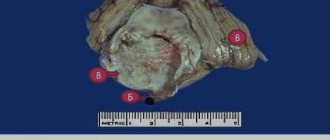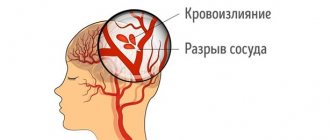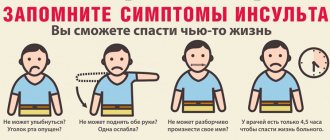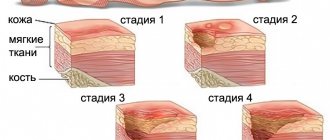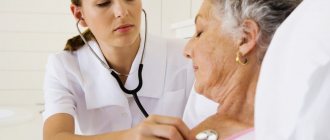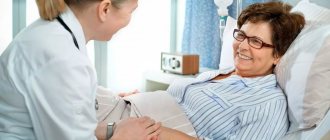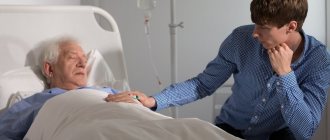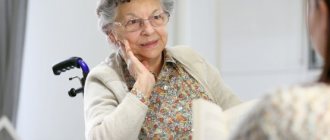24.11.2016
Pinchuk Elena Anatolyevna
Deputy chief physician for medical work, kmn, neurologist, doctor of physical and rehabilitation medicine
Lipovka Nadezhda Sergeevna
Head of the Department of Medical Rehabilitation, Physician of Physical and Rehabilitation Medicine, Neurologist
Sobolev Arkady Igorevich
Doctor of physical and rehabilitation medicine, neurologist
Normally, a person has elastic and strong blood vessels. However, high blood pressure and a number of other threatening factors make blood vessels fragile, as a result of which they are easily damaged. Such damage leads to a serious brain disease - stroke. Lesions may appear in different parts of the brain. One of the most dangerous places of occurrence is the brain stem. Hence the name of the disease – brainstem ischemic stroke.
The brain stem is an important link between the brain and the spinal cord. It is through it that all impulses and commands enter the human body. A brainstem stroke is dangerous because hemorrhage in this area completely blocks the normal functioning of other parts of the brain: the cerebellum, the middle and medulla pons, the pons, and the entire thalamic region. A lesion in this area not only disables facial muscles, eye movement, but also important centers that are responsible for blood circulation, breathing, and thermoregulation. An atrophied brainstem disrupts the functioning of all human internal organs.
Causes of brainstem stroke
Brainstem stroke occurs for the same reasons as other stroke subtypes:
- Poor nutrition;
- Constant and prolonged stress;
- Increased blood cholesterol levels;
- Overweight;
- Abuse of hormonal drugs;
- Alcohol and smoking;
- Bleeding disorders;
Often, a stroke can occur against the background of existing diseases, such as hypertension, rheumatism, vascular atherosclerosis, diabetes mellitus.
The danger of a brainstem stroke is that it develops very quickly and suddenly. Although it is accompanied by almost the same symptoms as ischemic stroke:
- Speech and articulation disorder;
- Dizziness, pale skin;
- Sweating;
- Fluctuations in body temperature;
- Rapid pulse, tachycardia;
- High blood pressure;
- Impaired functioning of the facial muscles, which leads to asymmetry and strabismus;
- Violation of movements, breathing, speech.
In some cases, paralysis may occur, affecting all parts of the body. However, a person does not lose his thinking abilities. Already in the process of treatment and recovery after a stroke, he is able to understand and evaluate what is happening.
If at least one of the above symptoms appears, you should call a doctor. The sooner a diagnosis is made and treatment is started, the greater the victim’s chance of recovery. A brainstem stroke is diagnosed using MSCT and MRI, and a neurologist also checks the state of the cardiovascular system and respiratory function.
Causes and symptoms
A tumor of the brain stem occurs due to various circumstances, and practice does not clearly answer what the main reason is. Most often, this disease is diagnosed in those who have received certain injuries, are in contact with chemicals, have been exposed to radiation, etc.
Despite the causes of the tumor, it is important to quickly respond to certain symptoms in order to consult a doctor in time. Surgical intervention provides certain guarantees for the success of treatment.
Main manifestations:
- Severe back pain;
- Headaches;
- Systematic dizziness;
- Loss of appetite;
- Vomiting on an empty stomach;
- Serious weight loss;
- Decreased concentration;
- General malaise;
- Changes in behavioral characteristics.
Such symptoms appear regardless of where the lesion in the brain stem occurs. But there are specific symptoms that indicate that the tumor is located in the central nervous system. This may be a gait disturbance, decreased balance, seizures, or muscle paralysis. Sleep may be disturbed, anxiety may arise, etc.
In any case, it is possible to determine where the tumor is located only as a result of carrying out all the necessary diagnostic measures. Most often, the doctor cannot determine the causes of the occurrence, but can give certain prognoses and prescribe the correct treatment depending on the symptoms and the results of the study. On the basis of which the operation will be prescribed and performed.
Treatment of brainstem stroke
The main therapy is aimed at eliminating the cause of the lesion - a blood clot or hemorrhage. Hematomas are removed surgically. If blood clots form, therapy is used to dissolve and prevent their formation. Drugs that thin the blood, regulate cholesterol levels, and control heart rate are administered. If respiratory function is lost, a special tube is inserted into the person's trachea to provide oxygen.
In most cases, a brainstem stroke leads to death, since most of the vital functions of the human body stop working. In order to avoid such a serious disease as a brainstem stroke, it is important to be regularly examined by doctors if you have other diseases of the cardiovascular system. It is also necessary to give up bad habits, lead a healthy lifestyle, and eliminate stressful situations from your life as much as possible.
Clinical Brain Institute Rating: 4/5 — 17 votes
Share article on social networks
Symptoms of various types of pathology
The signs of a stroke are very varied. They depend largely on which part of the brain is affected.
The most common symptoms:
- Impaired movements of the torso, arms, legs (from decreased strength to complete cessation of movement).
- Reduction of all types of sensitivity.
- Distortion of speech – the patient seems to be tongue-tied, speech is slow, unintelligible.
- Violation of statics - the patient is not able to stand independently, without outside support.
- Impaired consciousness: constant atypical drowsiness, “dullness” and even loss of consciousness.
Programs:
Assessment of rehabilitation potential
Movement restoration
Rehabilitation after stroke
Restoration of cognitive functions
Early (resuscitation) rehabilitation
Diagnosis of ischemic stroke in the elderly
Data from objective and instrumental research methods and their comprehensive competent assessment will help diagnose ischemic stroke in older people:
- neurological examination;
- Ultrasound examination of the arteries of the head and neck;
- computed and magnetic resonance imaging;
- angiography;
- transcranial Doppler ultrasound;
- electroencephalographic study.
Proper diagnosis will help distinguish ischemic stroke from hemorrhagic stroke. Neuroimaging techniques for studying the disease play an important role here. It is necessary to identify and differentiate between ischemic stroke and other brain diseases, for example, acute hypertensive encephalopathy. It is important to distinguish impaired brain activity due to blockage or spasm of blood vessels from toxic or metabolic types of encephalopathy, from brain tumors, abscesses, encephalitis and other brain lesions of an infectious nature.
Brain stem tumors
According to the previously existing opinion, any tumor of the brain stem was considered an infiltrative formation, diffusely growing into brain stem structures and, as a result, not subject to surgical removal. It has now become clear that in addition to diffusely spreading tumors (which, unfortunately, are the majority), there are limited nodular tumors in the trunk, the removal of which is quite possible. In such cases, to decide on the advisability of surgical treatment, the patient needs to consult a neurosurgeon. The dominant principle of trunk tumor removal is maximum resection of its tissue with minimal trauma to brain structures. In this regard, great hopes are placed on the development of microneurosurgical surgical techniques.
Unfortunately, about 80% of trunk tumors are inoperable. In relation to them, as well as as pre- and postoperative therapy, chemotherapy and radiation can be used. Chemotherapy is carried out using a combination of various cytostatic drugs. Radiation therapy achieves symptomatic improvement in 75% of patients. However, already in the early stages after treatment, many of them die. The technique of radiotherapy with an increase in the total dose of radiation has made it possible to slightly increase the life expectancy of children with stem tumors. In 30% of children, life expectancy after radiotherapy was 2 years.
Stereotactic radiosurgery is an innovative method for treating stem tumors today. It is possible to carry out 2 types of procedures: gamma knife and cyber knife. In the first case, a helmet is put on the patient’s head, irradiation is carried out from multiple sources so that their rays converge at one point corresponding to the location of the tumor. The effect is achieved due to the total impact of radiation sources, while the irradiation of healthy brain tissue is minimal, since each beam carries a small gamma energy. The procedure for targeting a tumor using a cyber knife is more automated. The robotic device itself directs the radiation to the area where the tumor is located, taking into account its movements due to the breathing or movements of the patient. However, so far these methods are effective mainly against benign tumors up to 3-3.5 cm in size.
Forecast
Benign tumors of the brain stem, due to their slow growth, can exist for up to 10-15 years, often having a subclinical course. But, unfortunately, most tumors in this area are malignant and cause death within several years or months from the onset of symptoms. Treatment in such cases only briefly prolongs the life of patients.
Memo on providing first aid to the elderly for ischemic stroke
At the first manifestation of symptoms of an ischemic stroke, it is necessary to call a team of doctors to provide emergency medical care. The effectiveness of further treatment directly depends on the timeliness of these actions. While the ambulance is traveling, you should prepare the elderly patient and take certain actions:
- The victim should be laid so that the shoulders and head are located above the body, this will help reduce blood pressure on the vessels of the brain. You cannot move or shift an elderly person - this can only make him worse.
- You should not give the patient anything to eat or drink while waiting for doctors because of the likelihood that the usual swallowing function will be disrupted; the person will choke or choke.
- It is strictly forbidden to give any medications before the ambulance arrives; you may not alleviate, but, on the contrary, aggravate the condition of an elderly relative.
- The oral cavity must be cleared of any secretions and objects (saliva, blood, mucus, food).
- Provide all conditions for free breathing: increase access to fresh air, remove tight clothing.
- If a person has lost consciousness but is breathing on his own, he must be turned on his side, his head resting on his arm and slightly tilted forward, and his leg bent at the knee so that it does not allow him to accidentally roll over.
- If there is no breathing, the elderly person is placed on his back and given artificial ventilation. If there is no pulse, cardiac massage is added to this procedure. For every two breaths there should be 30 heartbeats (2/30). These measures should be carried out only if you have the necessary skills and abilities until the victim begins to breathe on his own or until the ambulance arrives.
The development of ischemic stroke in older people occurs very quickly, which is why it is so important to provide qualified medical care literally in the first minutes and hours of the disease. Treatment must necessarily take place in the intensive care unit, where all efforts will be devoted to carrying out the necessary medical procedures. The faster this happens, the more favorable the prognosis and outcome of the disease. The optimal time for first aid and treatment is 2–4 hours from the onset of an attack. If you manage to carry out the necessary therapy in this short period of time, you may be able to avoid many complications.
